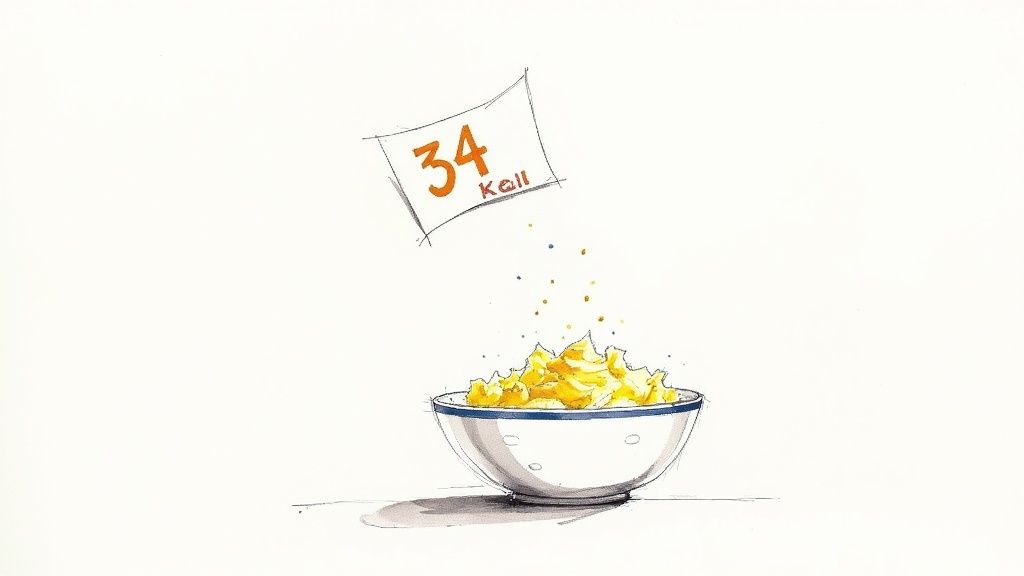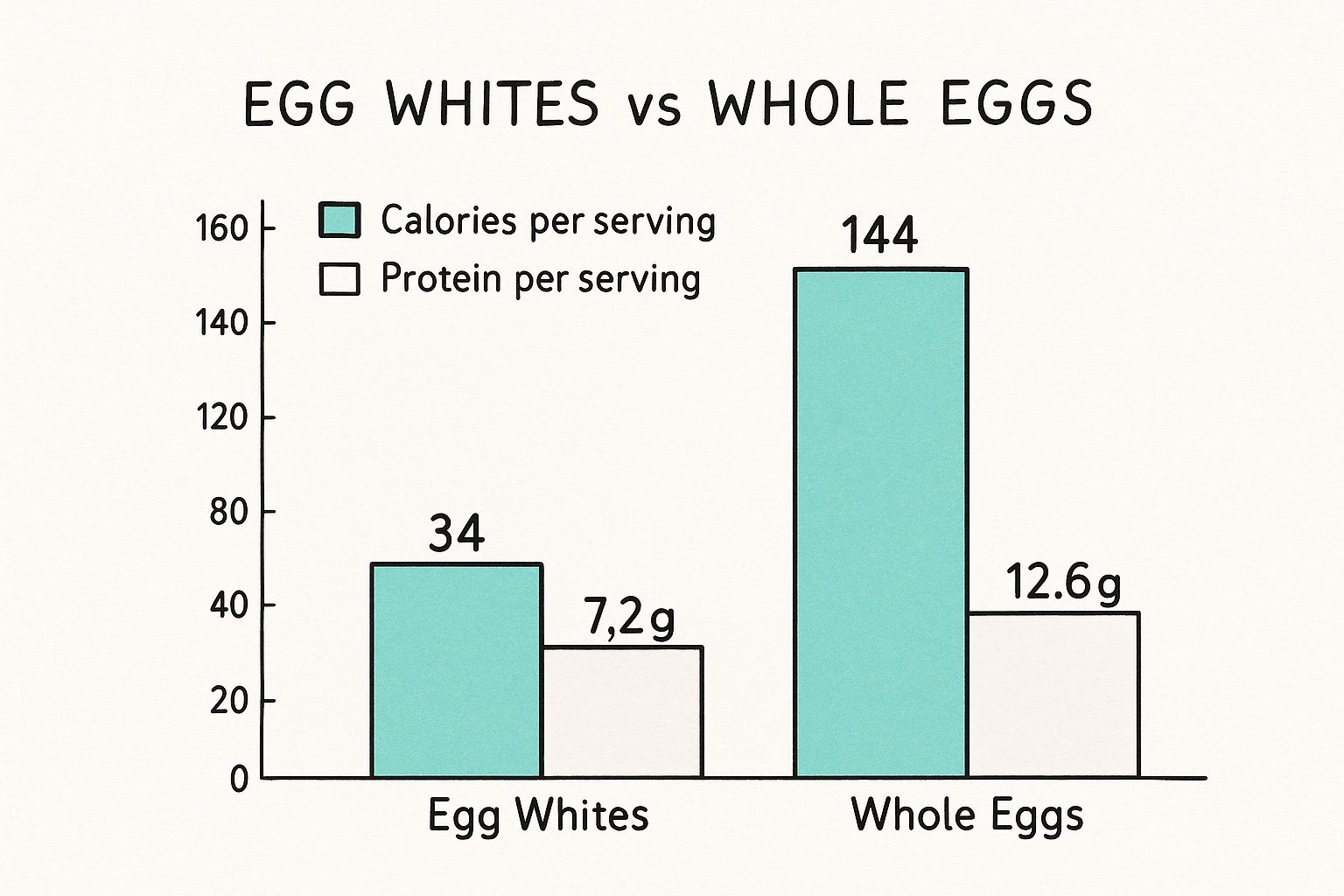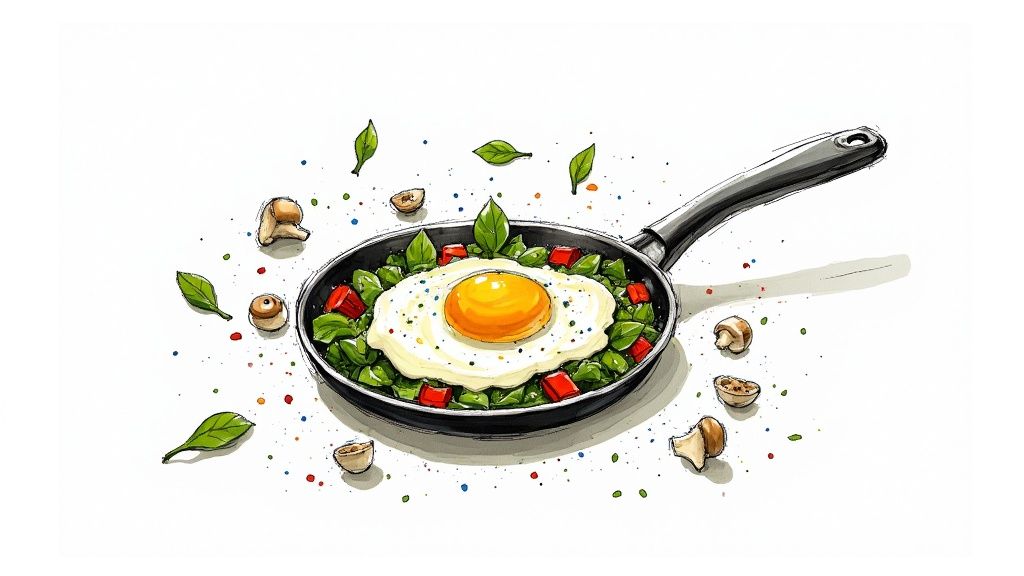How Many Calories Are in Scrambled Egg Whites? Let's Break It Down
Discover the calories in scrambled egg whites. This simple guide covers nutrition, protein, and healthy cooking tips for a perfect low-calorie breakfast.
Posted by
Figuring out the calories in scrambled egg whites is refreshingly simple. A standard serving made from two large egg whites contains only about 34 calories—and that’s before adding any oil or butter. This lean profile makes them an incredible choice for a filling, high-protein breakfast that won't weigh you down.
Why Egg Whites Are a Smart Breakfast Choice

Scrambled egg whites are more than just a low-calorie food; they're a smart breakfast staple for anyone looking to stay mindful of their nutrition without the stress. Think of them as a clean slate for your morning meal—pure protein that keeps you feeling full and energized, but without the extra fat or cholesterol found in the yolk.
This makes them incredibly versatile. Whether you're a busy professional needing a quick breakfast or a student looking for a simple, healthy start, their simplicity and protein punch are hard to beat.
And if you're curious about other ways to prepare them, our guide on the calories in boiled eggs without the yolk offers another great low-calorie perspective.
Scrambled Egg Whites Nutrition at a Glance
For a clear, at-a-glance summary, this table breaks down the nutritional profile of a standard serving of scrambled egg whites (from two large eggs), cooked without any added fat. It’s a simple way to see what you're getting.
| Nutrient | Amount per Serving (2 Large Egg Whites) |
|---|---|
| Calories | ~34 kcal |
| Protein | ~7.2 g |
| Fat | ~0.1 g |
| Carbohydrates | ~0.5 g |
| Cholesterol | 0 mg |
As you can see, you get a great protein boost for very few calories, making it an efficient way to start your day.
Packing a Protein Punch
The real magic of egg whites is their protein-to-calorie ratio. This is where they truly shine. While those two large egg whites give you about 7 grams of protein, it's incredibly easy to scale up.
A more substantial scramble using four whites, for example, can deliver a solid 14.4 grams of protein for only about 68 calories. This high-protein content is key for satiety—that feeling of fullness that helps you sidestep the urge to snack before your next meal. It makes managing your nutrition goals just a little bit easier.
Why Egg Whites Became a Breakfast Superstar

Ever wondered how the humble egg white became the darling of the breakfast menu? It wasn’t some overnight fad. This shift has roots going back decades, long before your local brunch spot started offering an egg-white-only scramble.
For a long time, nutritional advice zeroed in on the downsides of dietary fat and cholesterol. Suddenly, the rich, golden yolk—the part of the egg that contains all the fat—was cast as the villain. This created the perfect opportunity for the simple egg white to step into the limelight as the "healthier" choice.
The Rise of a Low-Fat Hero
This new perspective completely changed how we approached breakfast. Egg whites shot to fame for one simple reason: they were seen as pure protein, completely fat-free and cholesterol-free. As dietary guidelines began to push for lower fat intake in the late 20th century, health-conscious people started making the switch.
This isn't just a dusty history lesson; it's the origin story of your favorite healthy breakfast. It explains why a simple bowl of scrambled whites is still a go-to for anyone keeping a casual eye on their nutrition.
It was a simple trade-off that made sense to millions: keep the protein, but ditch the extra fat and cholesterol. This mindset is exactly why egg whites remain such a powerful staple for easy calorie tracking.
Of course, logging that meal should be just as easy. If your breakfast is "four egg whites and a handful of spinach," you should be able to just say it and have it tracked. That’s exactly what you can do with munchlog.ai, making mindful eating feel natural instead of like a chore. The history is interesting, but keeping track should be simple.
Unpacking the Full Nutritional Value
We've established that scrambled egg whites are impressively low in calories, but what else is going on in there? This is where they really shine, transforming from a simple diet-friendly food into a genuine nutritional powerhouse. It's all about what you get for that tiny calorie "price tag."
The real magic is the protein-to-calorie ratio. Egg whites are almost pure, high-quality protein. This is a game-changer for staying full and satisfied long after your meal is over. Think of it as premium fuel for your body—it helps you stay energized and kicks those mid-morning snack cravings to the curb, all without piling on extra calories from fat or carbs.
Egg Whites vs. Whole Eggs
To truly appreciate what egg whites bring to the table, it helps to put them head-to-head with whole eggs. When you decide to skip the yolk, you're making a calculated choice. You do lose out on some vitamins and all of the fat, but you also completely eliminate the cholesterol and slash the calorie count.
This quick comparison really puts the numbers into perspective.

As you can see, whole eggs pack a bit more protein, but they do so at more than four times the calorie cost. That makes egg whites the undisputed leaner choice.
This is an especially smart move if you're keeping an eye on heart health. A standard serving of scrambled egg whites is completely cholesterol-free, a stark contrast to whole eggs, where the yolk houses all of it. You can explore more about the nutritional breakdown of egg whites and see how they fit into your goals.
The bottom line is simple: If you're after a high-protein, incredibly lean meal, egg whites deliver. You're getting the most nutritional bang for your caloric buck, making your breakfast work that much harder for you.
And when it’s time to track your meal, don't get bogged down in the details. Just tell munchlog.ai, "I had a scramble with three egg whites," and the app will take care of the rest.
How Cooking Choices Affect Your Calorie Count
The way you prepare your scrambled egg whites can easily be the difference between a 34-calorie breakfast and one that packs more than double the punch. It seems like a tiny detail, but it's one that adds up fast, especially if you're trying to keep a casual eye on your intake.
The biggest game-changer? The fat you use in the pan.
Think of your egg whites as a blank slate. If you add just one teaspoon of butter, you're tossing in about 34 extra calories. Opt for olive oil instead? That's closer to 40 calories. While these fats add fantastic flavor, they also completely shift the nutritional profile of what started as a super-lean meal. This is where a little bit of awareness goes a long way.
Keeping Your Scramble Lean
So, how do you get that perfect, fluffy scramble without piling on the calories? Your best bet is a good non-stick cooking spray. It adds virtually zero calories, letting you enjoy the pure, lean protein of the egg whites without any extra baggage.
Your cookware also plays a huge role. The right pan can make all the difference, reducing or even eliminating the need for added oil. If you're in the market for an upgrade, this guide to the best healthy cooking pans is a great place to start looking for surfaces that support low-fat cooking.
Cooking Fat Comparison for Scrambled Egg Whites
To see just how much of an impact that little bit of fat has, here’s a quick breakdown of the approximate calories added to two scrambled egg whites based on what you put in the pan.
| Cooking Method (1 tsp) | Approximate Calories Added | Notes |
|---|---|---|
| Non-Stick Spray | ~0-1 kcal | The absolute leanest choice for keeping calories to a minimum. |
| Butter | ~34 kcal | Adds that classic rich flavor but also brings saturated fat. |
| Olive Oil | ~40 kcal | A heart-healthy fat, but it's still very calorie-dense. |
| Coconut Oil | ~40 kcal | Lends a unique flavor, but it’s another high-calorie option. |
As you can see, the numbers climb quickly. The key to accurate tracking isn't just knowing what you ate, but how you cooked it.
Being precise with your measurements is crucial for getting the numbers right. For a complete walkthrough, our article on how to weigh food for weight loss will help you master the skill.
The point isn't to demonize fats—they're an important part of a balanced diet. It’s all about being mindful of how they fit into your daily goals. And with Munchlog, you can simply say, "I had two scrambled egg whites cooked with a teaspoon of olive oil," and we'll take care of the math for you.
Flavorful Add-Ins That Keep Calories Low

Let's be real: plain scrambled egg whites can be a little bland. But think of them as the perfect blank canvas. You don't have to smother them in high-calorie sauces or cheese to make them taste incredible. It's all about building flavor smartly.
A big handful of fresh spinach is a fantastic starting point. It wilts down beautifully, packing in nutrients for only about 7 extra calories. Sautéed mushrooms and onions also bring a deep, savory flavor that can completely change the personality of your breakfast for just a few calories more.
Veggie-Packed Scrambles
Loading up on vegetables is probably the best trick in the book. It adds volume, satisfying texture, and a ton of flavor without really budging the calorie count. Plus, the added fiber will help you feel fuller for longer.
- Chopped Bell Peppers: A quarter-cup of diced red or green bell peppers gives you a sweet crunch and a pop of color for around 10 calories.
- Diced Onions: Finely chopping two tablespoons of onion creates a savory base for your scramble, adding only about 8 calories.
- Cherry Tomatoes: Halve a few cherry tomatoes and toss them in near the end of cooking. They add a burst of juicy, bright flavor for just 3-5 calories each.
A Little Something Extra
Sometimes, vegetables alone don't quite cut it. You want something more, and that's perfectly fine. A tiny amount of the right ingredient can deliver a huge flavor payoff.
The goal isn’t to eat a boring meal; it’s to be smart about where your flavor comes from. A sprinkle of cheese or a dash of herbs can make all the difference, turning a simple meal into something you genuinely look forward to.
For instance, one tablespoon of crumbled feta cheese completely transforms your scramble with a salty, tangy kick for only 25 calories. Fresh herbs like chives or dill are even better—they add a vibrant freshness for practically zero calories.
When it's time to track your meal, just tell munchlog.ai, "I had scrambled egg whites with spinach and feta," and the app will sort out the rest.
Logging Your Scramble Effortlessly with Voice
You've just whipped up the perfect, fluffy egg white scramble. It was quick, easy, and healthy. But now comes the part most of us dread: logging it. Fiddling with a tracking app, searching for ingredients, and tapping in amounts can kill the buzz of a simple, satisfying meal.
What if tracking was as easy as making the scramble? Instead of typing everything out, you could just say what you ate. This small shift makes a huge difference, turning food logging from a chore into a quick, natural habit. It’s the missing link between knowing the calories in scrambled egg whites and actually keeping a consistent record.
How Voice Logging Works
With munchlog.ai, you can literally just tell the app what you had for breakfast. Think of it less like data entry and more like leaving a quick voice memo for yourself. The app’s AI does all the heavy lifting, instantly translating your words into a neat nutritional log.
For example, you could just say: "I had a scramble with three egg whites, a handful of spinach, and a teaspoon of olive oil."
That’s all there is to it. No more searching for "egg whites, large" or trying to estimate what a "handful" of spinach is. The AI understands your natural language, breaks down each ingredient, and calculates the calories, protein, carbs, and fat for you in a snap. If you're curious about the tech that makes this happen, this guide on transcribing audio files gives a fascinating look at how spoken language is turned into structured data.
This voice-first approach is built for the real world—for those busy mornings when you don't have a spare second to mess with your phone. If you're looking for an easy food tracking app that actually fits into your life, this is how it’s done.
Got Questions About Egg Whites?
If you're making egg whites a go-to in your diet, you've probably got a few questions. It’s smart to be curious about what you're eating. Let's clear up a couple of the most common ones.
Are Those Liquid Egg Whites in a Carton Actually Healthy?
They absolutely are. Think of them as real egg whites, just made incredibly convenient. The main difference is that they've been pasteurized, a simple heating process that makes them safe to consume.
You get all the same high-quality protein without the hassle of cracking and separating eggs. Just make sure to give the ingredient list a quick scan—you're looking for 100% egg whites with no weird additives.
How Many Egg Whites Should I Eat for a Filling Breakfast?
For a breakfast that will actually keep you full until lunch, a good target is three to four large egg whites. This portion size packs a solid 12 to 17 grams of protein, which is key for feeling satisfied.
Want to make it even more satisfying? The trick is to add volume with fiber. Tossing in a big handful of spinach, some sliced mushrooms, or bell peppers will make your scramble feel much bigger without piling on the calories.
Ready to track your meals without the hassle? With munchlog.ai, just say what you ate and let our AI handle the rest. Start your effortless journey to better nutrition today.